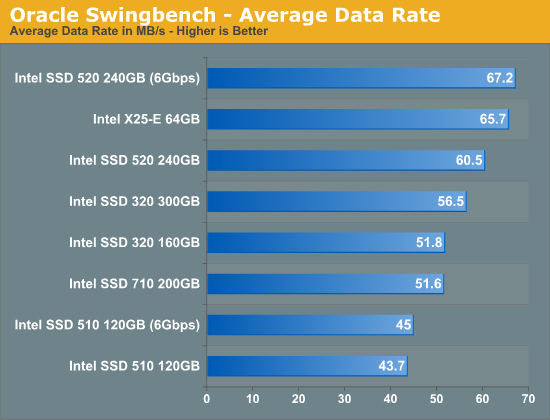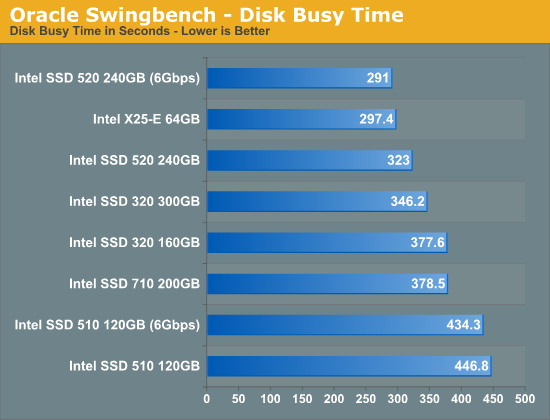A Look at Enterprise Performance of Intel SSDs
by Anand Lal Shimpi on February 8, 2012 6:36 PM EST- Posted in
- Storage
- IT Computing
- SSDs
- Intel
Enterprise Storage Bench - Oracle Swingbench
We begin with a popular benchmark from our server reviews: the Oracle Swingbench. This is a pretty typical OLTP workload that focuses on servers with a light to medium workload of 100 - 150 concurrent users. The database size is fairly small at 10GB, however the workload is absolutely brutal.
Swingbench consists of over 1.28 million read IOs and 3.55 million writes. The read/write GB ratio is nearly 1:1 (bigger reads than writes). Parallelism in this workload comes through aggregating IOs as 88% of the operations in this benchmark are 8KB or smaller. This test is actually something we use in our CPU reviews so its queue depth averages only 1.33. We will be following up with a version that features a much higher queue depth in the future.

SLC NAND offers great write latency and we see a definite advantage to the older drive here in our Swingbench test. Only a 6Gbps SSD 520 is able to deliver better performance, everything else trails the 3+ year old drive. Note that the Marvell based Intel SSD 510, even on a 6Gbps controller, is the slowest drive in Intel's lineup. From a write amplification perspective, Marvell's controller has always been significantly behind Intel's own creations so the drop in performance isn't surprising. The 710 actually delivers performance that's lower than the 320, but you do get much better endurance out of the 710.


While throughput isn't much better on the 6Gbps Intel SSD 520, average service time is tangibly lower. There's clearly a benefit to higher bandwidth IO interfaces in the enterprise space, which is a big reason we're seeing a tremendous push for PCIe based SSDs. The 710 does well here but not nearly as well as the X25-E which continues to behave like a modern SSD thanks to its SLC NAND.










55 Comments
View All Comments
Anand Lal Shimpi - Wednesday, February 8, 2012 - link
There's a *ton* of data that we manage. We run statistics, ad serving and forums all in house. Among other things, we can guarantee that no one funny is looking at the data we manage.Statistics are pretty beefy (they are one of our enterprise workloads after all) as we're tracking requests to all articles published. Couple a few hundred thousand readers per day with multiple article requests per reader and that's a lot of traffic to keep track of. Multiply all of that by a few ads per page and you can see where ad serving/tracking gets insane.
Then there are the forums. Repeat the same workload as above but across a different, but also quite large community.
The MS SQL server is main site, the My SQL server is forums + ads :)
Take care,
Anand
Lord 666 - Wednesday, February 8, 2012 - link
@Anand,What model server and what controller was it using with the qty 8 320 drives? Been waiting for an article like for this for some time.
Anand Lal Shimpi - Thursday, February 9, 2012 - link
The temporary hardware is a Dell R710 I believe. We're simply using Intel's Matrix RAID, no real need for a discrete PCIe RAID solution for what we're doing. I'll be providing more details about our final hardware configuration and how it compares to what we were running on for the past few years in the not too distant future.Take care,
Anand
mojobary - Thursday, February 9, 2012 - link
Hi,This is exactly the information I am interested in. I am a video editor, so my needs are typically long sequential reads. I would be interested in RAID adapters, iSCSI and Fibre channel RAID enclosures in respect to using SSDs. This is something that not much good information is present out in the wild. I have been researching this topic for about nine months and do not have conclusive information. Even from vendors which say "they support ssd", they don't list supported drives or even TRIM support. I typically like this site as it seems unbiased in the regard and usually helps me drive purchasing decisions.
bobbozzo - Monday, February 13, 2012 - link
HDDs are pretty good at sequential reads (and writes).For the same $, you'd be able to get more HDDs, and therefore higher sequential performance, than SSDs.
This will remain true until SSDs get MUCH faster sequential performance, or get MUCH cheaper than they currently are.
Movieman420 - Wednesday, February 8, 2012 - link
Given the 710's obvious benefit of using HET nand it'd be nice to see a comparison between it and an eMLC equipped Ocz SF2500 Deneva 2 drive. :evil grin:Anand Lal Shimpi - Thursday, February 9, 2012 - link
I'm trying to get more enterprise SSDs in house. I've got a bunch that I'm working on now actually. Not the Deneva 2 sadly :)Take care,
Anand
Sufo - Thursday, February 9, 2012 - link
How about the HP for ProLiant drives? Also, anything from Anobit?Is the 710 a realistic option for enterprise?
zepi - Wednesday, February 8, 2012 - link
I was hoping on some input regarding TRIM and SSD RAIDs in enterprise environments. What if I stick these babies to a proper raid-controller to run them in RAID 5? Or how about under other operating systems than Windows? Do the drives choke quickly if trim is not available or is it a non-issue? Does trim work in a software RAID array, assuming my operating system supports it? And how about trim / garbage collection behavior if the drives are never idle?Afaik Intel has released RAID 0- and RAID 1-compatible drivers that support trim, but only for Windows. Was that active in your test or does it even matter the slightest?
lonestar212 - Wednesday, February 8, 2012 - link
I was about ask exactly the same thing. Very curious about this!